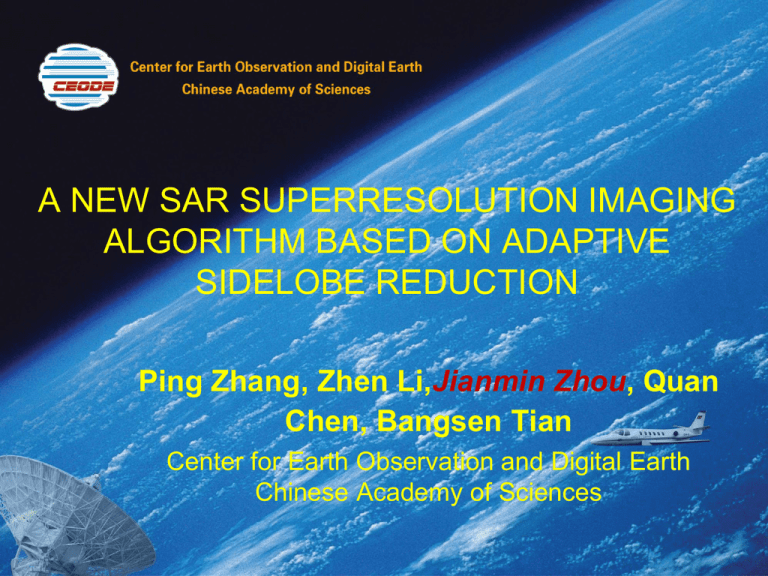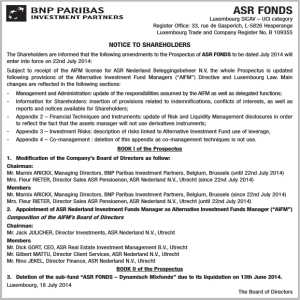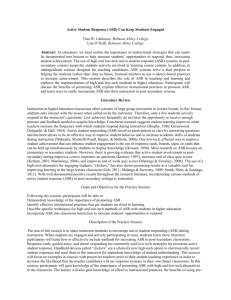Ping Zhang, Zhen Li,Jianmin Zhou, Quan Chen, Bangsen Tian
advertisement

A NEW SAR SUPERRESOLUTION IMAGING ALGORITHM BASED ON ADAPTIVE SIDELOBE REDUCTION Ping Zhang, Zhen Li,Jianmin Zhou, Quan Chen, Bangsen Tian Center for Earth Observation and Digital Earth Chinese Academy of Sciences Outlines • Problem with weighting in SAR • 2D ASR method • Resolution Enhancement algorithm Based on ASR • Results and Analysis • Conclusion Impact of Weighting SAR imagery based on conventional Fourier transform (FT) techniques often requires sidelobe control for the high sidelobes. It has traditionally been accomplished by using window functions such as Taylor, Hanning, Hamming, etc. 0 Rect Hamming Hanning Blackman -10 -20 However, the lower sidelobes have been achieved at the expense of broadening the mainlobe width, i.e. it degrades the image resolution. dB -30 -40 -50 -60 -70 -80 -80 -60 -40 -20 0 20 40 60 80 ASR Method • DeGraaf S.R. proposed ASR method to suppress sidelobes, which is a nonlinear operator based on cosine-on-pedestal frequency domain weighting functions, accomplished on a pixel-by-pixel basis which allows each pixel in an image to receive its own frequency domain aperture amplitude weighting function from a continuum of possible weighting functions. • ASR can effectively suppress sidelobes induced by finite-aperture without broadening the mainlobe of the impulse response. ASR takes advantage of the fact that cosine-on-pedestal weighting functions can be implemented as a multi-point convolution on a Nyquist sampled image. 2D ASR Method • The weight function of 2D ASR method is as follow 2 mr kr W nr , na , kr , ka 1 w nr , na , mr , ma cos mr 1 ma 1 kr M • • • • M 2 ma ka cos ka Where n 0, , N 1 , n 0, , N 1, k 0, , K 1 , k 0, w nr , na , mr , ma is weight coefficient, M is the order of weight coefficients, K r , K a is the number of signal samples within the signal bandwidth, • N r ,N a is the oversample number. r r a a r r a , Ka 1 2D ASR Method • The signal model can be expressed in frequency filed: Gˆ nr , na , kr , ka G kr , ka W nr , na , kr , ka • The signal in time filed is rewritten as gˆ (nr , na ) K r 1 K a 1 Gˆ (n , n , k , k )e r kr 0 ka 0 a r j 2 nkr Nr a j 2 e nka Na g (nr , na ) M M wn , n , m , m S n , n , m , m mr 1 ma 1 r a r a r a r a 2D ASR Method • Where: S nr , na , mr , ma N N Nr N 1 mr , na a ma g nr r mr , na a ma g nr 4 Kr Ka Kr Ka N N N N g nr r mr , na a ma g nr r mr , na a ma Kr Ka Kr Ka r Nr Kr a Na Ka • Let , to be oversample factor • S nr , na , mr , ma can be expressed 1 g nr r mr , na a ma 4 g nr r mr , na a ma S nr , na , mr , ma g nr r mr , na a ma g nr r mr , na a ma 2D ASR Method • The main idea of ASR is that if the signal sample is sidelobe, it can be identified by the data samples around it, and suppressed using the weights. • The optical weights can be obtained by minimizing the output energy of filter. • Generally if the oversample factor is noninteger, the signal should be upsample to integer sample number to make the weights efficient. 2D ASR Method • The choice of optical weights is derived as followed. Rewrite the time filed signal in matric form gˆ nr , na g nr , na wT nr , na y nr , na • In order to enhance the weights degree of freedom, we process the real component and imaginary component of SLC image partly • Let gˆ nr , na gˆr nr , na jgˆi nr , na and y nr , na yr nr , na jyi nr , na . 2D ASR Method • The output of the filter becomes T ˆ g n , n g n , n w r r a 1 nr , na yr nr , na r r a T ˆ g n , n g n , n w i r a 2 nr , na yi nr , na i r a • Minimize the output energy of the filter, min gˆ n , n 2 r r a 2 min gˆ i nr , na 2D ASR Method • Then we obtain the weights gr nr , na w nr , na T yr nr , na yr nr , na T 1 gi nr , na w2 nr , na T yi nr , na yi nr , na T 2D ASR Method • In order to obtain the efficient output, consider the l1 norm and l2 norm constraint on the weights, M M wn , n , m , m c m1 1 m2 1 M r a 1 2 M wn , n , m , m m1 1 m2 1 r a 1 2 1 2 1 c2 1 • where the parameter c1 in l1 norm and parameter c2 in l2 norm can be adjusted. Resolution Enhancement algorithm Based on ASR • After range direction compression, the time field signal is Sinc function. • If the image is integer Nyquist sampled, ASR is then applied to the image domain samples to remove the sidelobes directly. Otherwise the image should be upsampled to integer Nyquist sampled image. • Since ASR is a nonlinear operation, the resultant image is no longer band-limited after such processing. • When performing an inverse FFT to the ASR image, the resultant Fourier spectral domain data will have greater extent than the original data. Resolution Enhancement algorithm Based on ASR • The nonlinear ASR operation increases the original bandwidth, but introduces a magnitude taper that includes nulls. • For an ideal point scatter, this taper corresponds to the FFT of a Sinc mainlobe. • An inverse Hamming weight is then applied to equalize the magnitude taper over an aperture to smooth the ASR spectrum in order to approach to the spectrum shape of ideal point target. • ASR operation is finally applied to the bandwidth extrapolated Fourier spectral data to obtain a sidelobe reduction image. Resolution Enhancement algorithm Based on ASR • The steps of the algorithm are shown in the following Raw Data General SAR Imaging Method SLC Image ASR Image after ASR FFT Phase History Data Cosine Inverse Weights Extended Phase History Data IFFT Image Field ASR Superresolution Image Results and Analysis • Figures show the results of simulated point scatter using different methods. (a) is the unwindowed Fourier image. (b) is the imaging result using the paper’s method. -30 -30 -20 -20 -10 距离向(m) 距离向(m) -10 0 0 10 10 20 20 30 30 -30 -20 -10 0 方位向(m) (a) 10 20 30 -30 -20 -10 0 方位向(m) 10 20 30 (b) • The resolution enhancement can be shown obviously and sidelobes are also suppressed very well. Results and Analysis • Table is the performance compared between the conventional method and the paper’s method. We can easily see the improvement in resolution, peak sidelobe ratio (PSLR) and integral sidelobe ratio (ISLR) in two directions. Performance Index Fourier Method Paper’s Method Range resolution(m) 1.0544 0.7983 Range PSLR(dB) -13.4213 -26.9950 Range ISLR(dB) -10.1341 -24.2225 Azimuth resolution(m) 1.1044 0.8270 Azimuth PSLR(dB) -12.3295 -24.3613 Azimuth ISLR(dB) -8.9495 -22.0205 Results and Analysis 距离向 距离向 Figures show the result of SIR-C data using different methods. The data is obtained in 1994 of some city in Taiwan, which data process number is 51581. 方位向 (a) RD Method 方位向 Method (b) The Paper’s Compared the two figures, we can see the river edge is clearer in (b). From the middle white circle, the targets docked at the land can be distinguished easily in (b). So the resolution can be enhanced obviously and sidelobes can also be suppressed very well. Conclusion • The paper provides an efficient extrapolation algorithm to enhance resolution as well as reduce sidelobes, which is based on ASR. • The processing of algorithm is simple to operate. • Simulation experiments show the validity of the algorithm. Comparing to the Fourier method, the proposed algorithm obtains better results. • The image characteristics after the processing of the paper’s method should be analyzed in the future.








